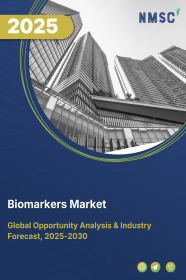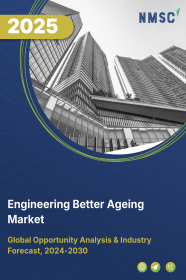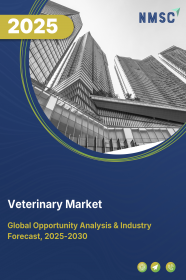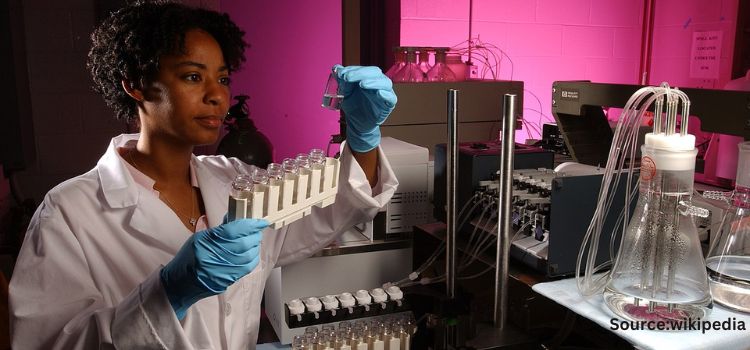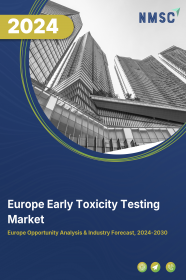
Europe Early Toxicity Testing Market by Technique (In Vivo, In Vitro, and In Silico), by Toxicity Endpoint (Genotoxicity, Dermal Toxicity, Skin Toxicity, Ocular Toxicity, Phototoxicity, and Others), by End User (Pharmaceutical Industry, Cosmetic Industry, Chemical Industry, Food Industry, and Others) – Opportunity Analysis and Industry Forecast, 2023-2030
Industry: Healthcare | Publish Date: 03-Dec-2024 | No of Pages: 157 | No. of Tables: 132 | No. of Figures: 81 | Format: PDF | Report Code : HC731
US Tariff Impact on Europe Early Toxicity Testing Market
Trump Tariffs Are Reshaping Global Business
Market Definition
Europe Early Toxicity Testing Market was valued at USD 1.07 billion in 2022, and is predicted to reach USD 2.19 billion by 2030, with a CAGR of 8.04% from 2023 to 2030.
Early toxicity testing is a fundamental procedure aimed at assessing the potential toxicity or adverse effects of drugs, chemicals, or various substances during their preliminary developmental stages. Typically conducted in vitro or through animal models, this evaluation occurs prior to any human testing.
The overarching objective of early toxicity testing is to swiftly uncover any safety-related apprehensions linked to a substance, thus facilitating informed decisions about its feasibility for continued development and subsequent testing.
By undertaking early toxicity testing, the risks of adverse effects on both human subjects and animals during clinical trials are mitigated, simultaneously curtailing expenses and time invested in the overall drug development trajectory.
This intricate process encompasses a gamut of examinations and assays, encompassing cell viability assessments, genotoxicity evaluations, and pharmacokinetic investigations.
The specific modalities employed are contingent on the intrinsic nature of the substance under scrutiny and its intended application. Recognized as an indispensable phase within the drug development journey, early toxicity testing profoundly bolsters the assurance of safety and efficacy for novel drugs and other substances, prior to their regulatory endorsement for human utilization.
Surge in Chronic Diseases in Developed European Nations Fuels ETT Market Growth
Europe consists of developed nations such as the UK, Germany, and Denmark. Growth in prevalence of chronic diseases in Europe that may require long-term treatment with medications, which can have toxic effects on body propels growth of the ETT market.
The surge in chronic diseases represents a pressing health concern that has far-reaching implications. Conditions such as cardiovascular diseases, diabetes, cancer, and neurological disorders are increasingly prevalent within the European population. As these chronic diseases become more widespread, the necessity for effective and safe treatment regimens has gained paramount importance.
For instance, 35% or more than one-third of the population in the region reported a long-standing chronic health problem in 2021.
Escalating Investments in Research and Development Catalyze Market Expansion in Europe
The increase in investments in research and development by pharmaceutical companies and governments in this region further drives the market growth. As a critical aspect of drug development, early toxicity testing is experiencing significant growth in Europe, and it is expected to continue as pharmaceutical companies aim to meet rise in demand for innovative medicines.
Regulatory Constraints and their Impact on Early Toxicity Testing Market Growth in Europe
However, stringent regulations set by regulatory bodies such as the US FDA and the EMA require extensive and rigorous testing for drug development and safety, which can be time-consuming and expensive and restrain growth of the market. The complexity and cost of complying with these regulations can pose a significant challenge for small and medium-sized companies that may not have the resources to carry out extensive testing.
As a result, some companies may choose to delay or abandon drug development projects, which can limit demand for early toxicity testing services.
Moreover, stringent regulations can also result in a lengthy approval process for new drugs, further delaying the time it takes for drugs to reach the market. This, in turn, is expected to hamper growth of the market.
Technological Advancements in the field of Early Toxicity Testing Market in Europe
Introduction of new technologies such as in-vitro modelling using 3D cell culture is expected to provide new lucrative opportunities for the early toxicity testing market during the forecast period. Use of 3D cell cultures can better mimic complexity of tissues and organs, providing more accurate and reliable results for toxicity testing.
Traditional 2D cell culture models are limited in their ability to mimic complexity of human tissues and organs, often leading to inaccurate and unreliable results in toxicity testing.
However, use of 3D cell culture models can better mimic structural and functional complexity of tissues and organs, providing more accurate and reliable results for toxicity testing.
3D cell cultures allow growth and interaction of multiple cell types, creating a microenvironment that more closely resembles human tissues and organs. This can better predict toxic effects of drugs and chemicals in the human body, reducing the risk of adverse effects in clinical trials. Hence, such factors propel the market growth.
Competitive Landscape
The Europe early toxicity testing industry includes several market players such as Inotiv Inc., Bio-Rad Laboratories Inc, Evotec A.G., Agilent Technologies Inc, Wuxi Apptec, Bruker, Perkinelmer Inc., Enzo Biochem Inc., Danaher Corporation, Eurofins Scientific SE, Charles River Laboratories International, Inc., Labcorp Drug Development., Promega Corporation, Insphero AG., and Thermo Fisher Scientific Inc.
KEY BENEFITS
-
The Europe early toxicity testing market report provides a quantitative analysis of the current market and estimations through 2023-2030 that assists in identifying the prevailing market opportunities to capitalize on.
-
The study comprises a deep dive analysis of the market trend including the current and future trends for depicting the prevalent investment pockets in the industry.
-
The information related to key drivers, restraints, and opportunities and their impact on the market is provided in the report.
-
The competitive analysis of the key players along with their market share in the Europe early toxicity testing market.
-
The SWOT analysis and Porter’s Five Forces model are elaborated in the study.
-
Value chain analysis in the market study provides a clear picture of the stakeholders’ roles.
Europe Early Toxicity Testing Market Key Segments
By Technique
-
In Vivo
-
In Vitro
-
Cell Culture
-
PCR
-
ELISA
-
Western Blotting
-
Protein Binding Assays
-
-
In Silico
By Toxicity Endpoint
-
Genotoxicity
-
Dermal Toxicity
-
Skin Toxicity
-
Ocular Toxicity
-
Phototoxicity
-
Others
By End User
-
Pharmaceutical Industry
-
Cosmetic Industry
-
Chemical Industry
-
Food Industry
-
Others
By Geography
-
Europe
-
The UK
-
Germany
-
France
-
Spain
-
Italy
-
Netherlands
-
Denmark
-
Finland
-
Norway
-
Sweden
-
Russia
-
REPORT SCOPE AND SEGMENTATION:
|
Parameters |
Details |
|
Market Size in 2022 |
USD 1.07 Billion |
|
Revenue Forecast in 2030 |
USD 2.19 Billion |
|
Growth Rate |
CAGR of 8.04% from 2023 to 2030 |
|
Analysis Period |
2022–2030 |
|
Base Year Considered |
2022 |
|
Forecast Period |
2023–2030 |
|
Market Size Estimation |
Billion (USD) |
|
Growth Factors |
The surge in chronic diseases.
Escalating investments in research and development. |
|
Countries Covered |
11 |
|
Companies Profiled |
15 |
|
Market Share |
Available for 15 companies |
|
Customization Scope |
Free customization (equivalent up to 80 working hours of analysts) after purchase. Addition or alteration to country, regional, and segment scope. |
|
Pricing and Purchase Options |
Avail customized purchase options to meet your exact research needs. |
Key Players
-
Inotiv Inc.
-
Bio-Rad Laboratories Inc
-
Evotec A.G.
-
Agilent Technologies Inc
-
Wuxi Apptec
-
Bruker
-
Perkinelmer Inc.
-
Enzo Biochem Inc.
-
Danaher Corporation
-
Eurofins Scientific SE
-
Charles River Laboratories International, Inc.
-
Labcorp Drug Development.
-
Promega Corporation
-
Insphero AG
-
Thermo Fisher Scientific Inc.

















 Speak to Our Analyst
Speak to Our Analyst



